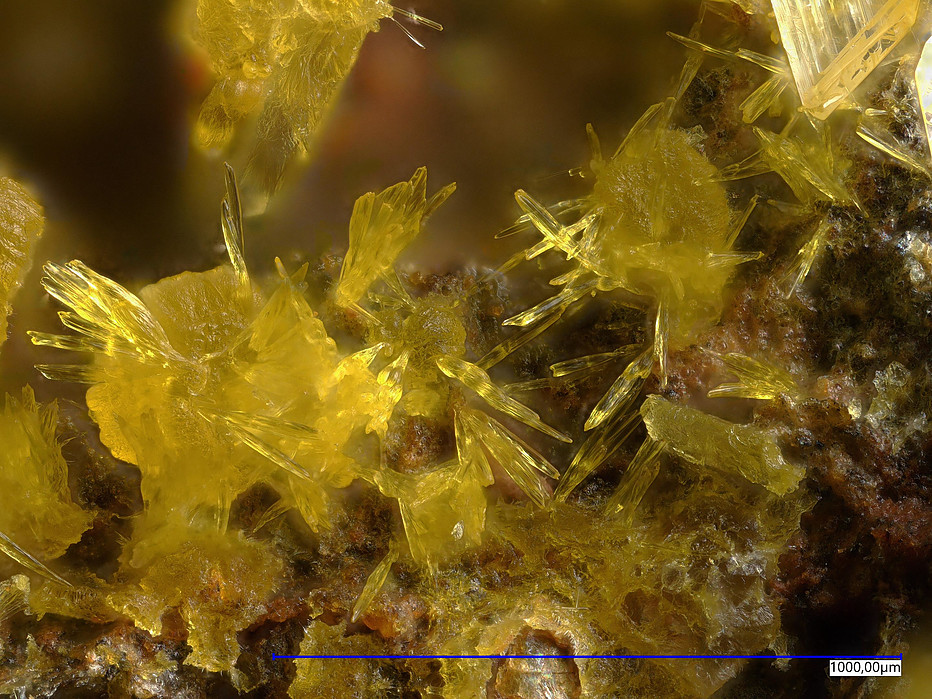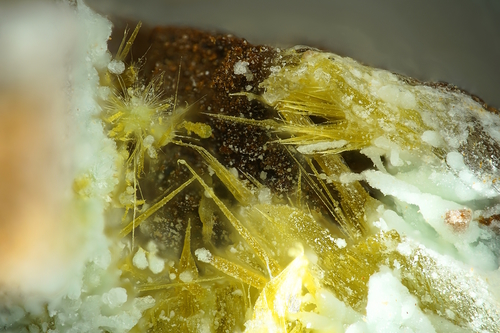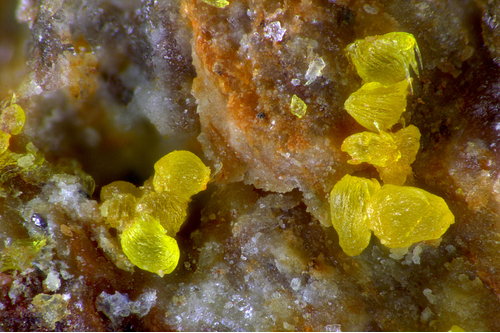Blatonite
A valid IMA mineral species
This page is currently not sponsored. Click here to sponsor this page.
About Blatonite
Formula:
(UO2)CO3 · H2O
Colour:
Canary yellow
Lustre:
Silky
Hardness:
2 - 3
Specific Gravity:
4.05
Crystal System:
Hexagonal
Name:
Named in 1998 by R. Vochten and Michel Deliens in honor of Dr. Norbert Blaton [Zwalm, East-Flanders province, Belgium, May 25 1945-], crystallographer at the University of Leuven, Belgium, a specialist on the crystal structure of uranium minerals.
A secondary uranium mineral.
Chemically, simple uranyl(VI) carbonate monohydrate.
Chemically, simple uranyl(VI) carbonate monohydrate.
Unique Identifiers
Mindat ID:
6826
Long-form identifier:
mindat:1:1:6826:6
GUID
(UUID V4):
(UUID V4):
dc9c096c-01d8-49a5-880f-16e240acf04f
IMA Classification of Blatonite
Approved
IMA Formula:
(UO2)(CO3) · H2O
Approval year:
1997
First published:
1998
Classification of Blatonite
5.EB.10
5 : CARBONATES (NITRATES)
E : Uranyl Carbonates
B : UO2:CO3 = 1:1
5 : CARBONATES (NITRATES)
E : Uranyl Carbonates
B : UO2:CO3 = 1:1
Mineral Symbols
As of 2021 there are now IMA–CNMNC approved mineral symbols (abbreviations) for each mineral species, useful for tables and diagrams.
| Symbol | Source | Reference |
|---|---|---|
| Blt | IMA–CNMNC | Warr, L.N. (2021). IMA–CNMNC approved mineral symbols. Mineralogical Magazine, 85(3), 291-320. doi:10.1180/mgm.2021.43 |
Physical Properties of Blatonite
Silky
Transparency:
Translucent
Colour:
Canary yellow
Streak:
White
Hardness:
2 - 3 on Mohs scale
Tenacity:
Flexible
Fracture:
Irregular/Uneven
Density:
4.05(2) g/cm3 (Measured) 4.02 g/cm3 (Calculated)
Comment:
Measured in Clerici solution. Calculated value is based on ideal formula.
Optical Data of Blatonite
Type:
Uniaxial (+)
RI values:
nω = 1.588(2) nε = 1.612(2)
Max Birefringence:
δ = 0.024

Image shows birefringence interference colour range (at 30µm thickness)
and does not take into account mineral colouration.
and does not take into account mineral colouration.
Surface Relief:
Moderate
Pleochroism:
Non-pleochroic
Comments:
Length fast
Chemistry of Blatonite
Mindat Formula:
(UO2)CO3 · H2O
Elements listed:
Crystallography of Blatonite
Crystal System:
Hexagonal
Cell Parameters:
a = 15.79(1) Å, c = 23.93(3) Å
Ratio:
a:c = 1 : 1.516
Unit Cell V:
5,166.99 ų (Calculated from Unit Cell)
Z:
36
Comment:
Point Group: n.d.; Space Group: n.d
X-Ray Powder Diffraction
Powder Diffraction Data:
| d-spacing | Intensity |
|---|---|
| 3.056 Å | (100) |
| 6.56 Å | (77) |
| 6.91 Å | (55) |
| 7.86 Å | (47) |
| 4.76 Å | (40) |
| 4.34 Å | (36) |
| 3.39 Å | (33) |
Geological Environment
Paragenetic Mode(s):
| Paragenetic Mode | Earliest Age (Ga) |
|---|---|
| Stage 7: Great Oxidation Event | <2.4 |
| 47a : [Near-surface hydration of prior minerals] | |
| 47c : [Carbonates, phosphates, borates, nitrates] | |
| 47f : [Uranyl (U⁶⁺) minerals] |
Type Occurrence of Blatonite
General Appearance of Type Material:
Very thin asbestiform aggegates; the bundles of needle-shaped subparallel fibers are up to 0.1 mm in width and 1 mm in length. Some crystals are fan-like and terminated.
Place of Conservation of Type Material:
Royal Belgian Institute of Natural Sciences, Brussels
Geological Setting of Type Material:
oxidized portions of a roll-front-type uranium deposit
Associated Minerals at Type Locality:
Reference:
Vochten, R., Deliens, M. (1998) Blatonite, UO2CO3·H2O, a new uranyl carbonate monohydrate from San Juan County, Utah. The Canadian Mineralogist: 36: 1077-1081.
Synonyms of Blatonite
Other Language Names for Blatonite
Common Associates
Associated Minerals Based on Photo Data:
| 4 photos of Blatonite associated with Gypsum | CaSO4 · 2H2O |
| 2 photos of Blatonite associated with Malachite | Cu2(CO3)(OH)2 |
| 2 photos of Blatonite associated with Magnioursilite | Mg4(UO2)4(Si2O5)5(OH)6 · 20H2O |
| 1 photo of Blatonite associated with Alunite | KAl3(SO4)2(OH)6 |
| 1 photo of Blatonite associated with Rutherfordine | (UO2)CO3 |
| 1 photo of Blatonite associated with Joliotite | (UO2)CO3 · nH2O |
| 1 photo of Blatonite associated with Magnesiozippeite | Mg(UO2)2(SO4)O2 · 3.5H2O |
| 1 photo of Blatonite associated with Leesite | K(H2O)2[(UO2)4O2(OH)5] · 3H2O |
| 1 photo of Blatonite associated with Chukhrovite-(Y) | Ca3(Y,Ce)(AlF6)2(SO4)F · 10H2O |
Related Minerals - Strunz-mindat Grouping
| 5.EB.05 | Rutherfordine | (UO2)CO3 |
| 5.EB.15 | Joliotite | (UO2)CO3 · nH2O |
| 5.EB.20 | Bijvoetite-(Y) | Y8(UO2)16(CO3)16O8(OH)8 · 39H2O |
Fluorescence of Blatonite
Fluoresces strongly greenish yellow under 360 nm UV
Other Information
Notes:
Soluble with effervescence in dilute mineral acids and in dilute organic acids such as acetic acid.
Health Risks:
No information on health risks for this material has been entered into the database. You should always treat mineral specimens with care.
Internet Links for Blatonite
mindat.org URL:
https://www.mindat.org/min-6826.html
Please feel free to link to this page.
Please feel free to link to this page.
Search Engines:
External Links:
Mineral Dealers:
References for Blatonite
Localities for Blatonite
Locality List
 - This locality has map coordinates listed.
- This locality has map coordinates listed.
 - This locality has estimated coordinates.
ⓘ - Click for references and further information on this occurrence.
? - Indicates mineral may be doubtful at this locality.
- This locality has estimated coordinates.
ⓘ - Click for references and further information on this occurrence.
? - Indicates mineral may be doubtful at this locality.
 - Good crystals or important locality for species.
- Good crystals or important locality for species.
 - World class for species or very significant.
(TL) - Type Locality for a valid mineral species.
(FRL) - First Recorded Locality for everything else (eg varieties).
- World class for species or very significant.
(TL) - Type Locality for a valid mineral species.
(FRL) - First Recorded Locality for everything else (eg varieties).
All localities listed without proper references should be considered as questionable.
Czech Republic | |
| Jakub Plasil |
| Travis Olds collection |
Germany | |
| Bayerl et al. (12/21) |
| Möhn et al. (09/2020) |
Italy | |
| Gamboni et al. (2021) |
| Gamboni et al. (2021) |
| //doi.org/10.57635/MICRO.2023.21.9 |
Peru | |
| Douglas Bank Information July 2022 |
USA (TL) | |
| Min News 14:10 p 4 +2 other references |
Quick NavTopAbout BlatoniteUnique IdentifiersIMA Classification Classification Mineral SymbolsPhysical Properties Optical Data Chemistry Crystallography X-Ray Powder DiffractionGeological EnvironmentType Occurrence SynonymsOther LanguagesCommon AssociatesStrunz-MindatFluorescence Other InformationInternet Links References Localities Locality List







 symbol to view information about a locality.
The
symbol to view information about a locality.
The 



Jomac Mine, White Canyon Mining District, San Juan County, Utah, USA